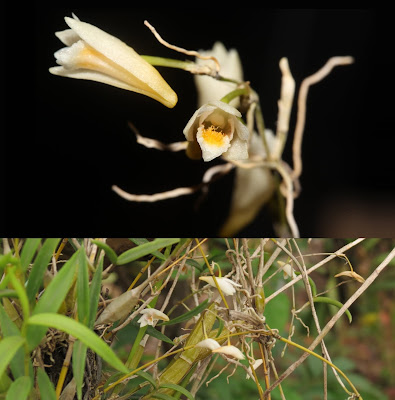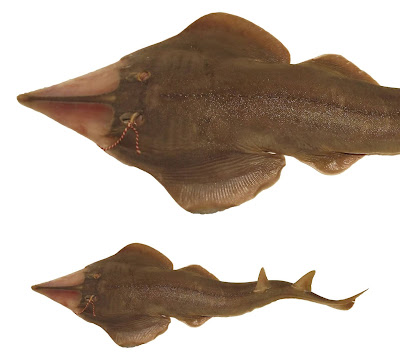[Most Recent Entries] [Calendar View]
Monday, August 23rd, 2021
| Time | Event | ||
| 3:20a | [Botany • 2021] Dendrobium parahendersonii • A New Orchid Species (sect. Crumenata: Orchidaceae) from Southern Vietnam
Abstract Dendrobium parahendersonii discovered in southern Vietnam is described as new species to science. It belongs to D. sect. Crumenata, and resembles D. hendersonii and D. exile in having a filiform, reed-like stem swollen at the base into a quadrangular ellipsoid pseudobulb and flowering from the leafless part of stem but differs clearly in the details of its tepals and lip. A morphological description, illustrations, data on habitat, phenology, and conservation status for the new species are provided. Keyword: Crumenata, Dendrobium hendersonii, new species, Orchidaceae, plant diversity, plant taxonomy Dendrobium parahendersonii Vuong, Aver. & Nguyen V.C., sp. nov. Diagnosis. The new species is morphologically similar to D. hendersonii but clearly differs by quadrangular pseudobulbs, quadrate or sub-quadrate in cross section (vs. pseudobulbs distinctly flattened, rhomboid in cross-section), smaller flower ca. 1 cm long (vs. 2–2.5 cm long), shorter pedicel and ovary ca. 5 mm long (vs. pedicel and ovary up to 1 cm long), smaller median sepal ca. 5 mm long, 2 mm wide (vs. median sepal 10–15 mm long, 4–6 mm wide), median lip lobe halfcircular (vs. median lip lobe narrowly oblong), lip disc with 5 distally fimbriate keels (vs. lip disc distally with almost glabrous tripartite callus). Morphological details of D. hendersonii used for the comparison are based on data reported by Wood (2015). Etymology. The species name refers its closest relation to D. hendersonii.Habitat and phenology. Trunk and branch epiphyte in broadleaved evergreen and semideciduous lowland and submontane forests at elevation 200–800 m a.s.l. Flowers all around the year, usually after light short weather cooling. Distribution. Vietnam, provinces Dong Nai (Vinh Cuu District), Khanh Hoa (Ninh Hoa District), and Lam Dong. Endemic of the eastern part of Central Highlands in southern Vietnam. Van Canh Nguyen, Leonid V. Averyanov, Tatiana V. Maisak, Thi Lien Thuong Nguyen, Van Khuong Nguyen and Ba Vuong Truong. 2021. Dendrobium parahendersonii, A New Orchid Species (Orchidaceae) from Southern Vietnam. Taiwania. 2021 66(3); 360-363. DOI: 10.6165/tai.2021.66.360 | ||
| 4:40a | [Herpetology • 2021] Reassessment of Tantilla boipiranga (Serpentes: Colubridae: Colubrinae) and A Preliminary Approach to the Phylogenetic Affinities within Tantilla
Abstract Tantilla is one of the most diverse genera among colubrids, with 67 species arranged in six phenotypically recognized species groups. Tantilla boipiranga is the most recently described species within the T. melanocephala group, and it was described based on a small type series, collected in the rupestrian grasslands of south-eastern Brazil. The morphological diversity and the phylogenetic affinity of this species remain poorly known. Here, based on the assessment of recently collected specimens in combination with results of a molecular phylogenetic analysis, we evaluate the morphological variation within T. boipiranga and its phylogenetic position. Our analyses confirm T. boipiranga as genetically distinct from its generic counterparts, and diagnosable based on a combination of colour pattern, meristic counts, and hemipenial morphology. However, contrary to its original description, the hemipenial ornamentation does not differentiate T. boipiranga from the highly variable T. melanocephala. In our phylogenetic analysis, T. boipiranga is retrieved as a monophyletic group, nested within the diversity of T. melanocephala and sister to a clade composed by specimens from south-eastern Brazil. Tantilla melanocephala is recovered as a highly diverse lineage, indicating the possible presence of undescribed species. Additionally, our analysis indicates that the T. coronata and T. planiceps species group are monophyletic, while the T. taeniata species group is paraphyletic and the only sampled species for the T. calamarina group is nested within the T. melanocephala group. Our results suggest that the phenotypic evolution within the genus is probably more complex than previously recognized, and some colouration patterns used to define the groups can in fact represent phenotypical convergences. Moreover, our phylogenetic analysis suggests a strong signal of geographical structure in the tree topology. Three main geographical lineages were found, a North American, a South American and a Central American. The first two lineages were recovered as monophyletic, while the latter is paraphyletic, with Central American species positioned as sister groups of both, the North American and the South American clades. Although a more comprehensive phylogenetic analysis is needed, our study strongly indicates the existence of hidden diversity within the T. melanocephala group and that Tantilla represents an ideal model to evaluate the validity of phenotypical groups in snake systematics and to study the driven mechanisms of morphological evolution. Key words. Squamata, Colubridae, Sonorini, fossorial snakes, snake biogeography, snake systematics, snake taxonomy, phylogeny, molecular phylogenetics, comparative morphology Tantilla boipiranga Sawaya & Sazima, 2003 Weverton dos Santos Azevedo, Francisco Luís Franco, Hans Thomassen, Thiago Marcial de Castro, Arthur Diesel Abegg, Felipe Sá Fortes Leite, Jaqueline Battilana and Felipe Gobbi Grazziotin. 2021. Reassessment of Tantilla boipiranga (Serpentes: Colubrinae) and A Preliminary Approach to the Phylogenetic Affinities within Tantilla. Salamandra. 57(3); 400-412. | ||
| 9:24a | [Ichthyology • 2021] Glaucostegus younholeei • A New Species of Giant Guitarfish (Rhinopristiformes: Glaucostegidae) from the northern Bay of Bengal, Bangladesh
Abstract A new species of giant guitarfish, Glaucostegus younholeei sp. nov., is described from 13 specimens, 730–933 mm total length, collected from fish landing center of Bangladesh Fisheries Development Corporation in Cox’s Bazar district of Bangladesh. The new species is distinguished from congeners in having the following combination of characters: Body brownish or greyish in color with a narrowly wedge-shaped disc, and long narrow bluntly pointed snout (angle 31–40°), and broad oblique nostrils with the narrow anterior opening. Nostrils about half of the mouth width, subequal (0.98–1.33) to internasal width; ~55–57 nasal lamellae; anterior nasal flaps slightly penetrating into internasal space, their interspace 2.20– 2.61 in length of the posterior nasal aperture. Orbit very small in adults, diameter 8.19–11.62 in preorbital length, 2.25–2.69 in interorbital space. Rostral ridges almost joined along their entire length; margin of cranium sharply demarcated before eyes. Spiracular folds very short and widely separated. Skin rough, densely covered with small denticles, more coarsely granular on the dorsal surface than ventrally, enlarged between orbits and in a distinct band between nape and first dorsal fin. Tail relatively longer, length 1.15–1.48 in disc length; dorsal fins narrowly spaced, interspace 1.32–2.11 in base length of the first dorsal fin. Clasper length in adult male 4.37–5.70 in total length. Phylogenetic analysis of DNA barcode sequences also shows the clear divergence of Glaucostegus younholeei from other congeneric species obtained from GenBank. A key is provided to the 8 known members including new species of the genus Glaucostegus. Keywords: Pisces, Bangladeshi guitarfish, taxonomy, morphology, DNA Barcoding, Vulnerable Kazi Ahsan Habib and Md Jayedul Islam. 2021. Description of A New Species of Giant Guitarfish, Glaucostegus younholeei sp. nov. (Rhinopristiformes: Glaucostegidae) from the northern Bay of Bengal, Bangladesh. Zootaxa. 4995(1); 129-146. DOI: 10.11646/zootaxa.4995.1.7 |
| << Previous Day |
2021/08/23 [Calendar] |
Next Day >> |












